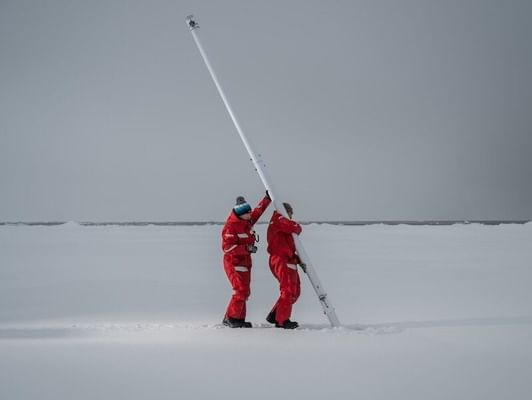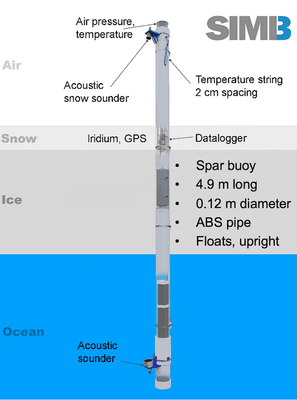- Undergraduate
Bachelor's Degrees
Bachelor of ArtsBachelor of EngineeringDual-Degree ProgramUndergraduate AdmissionsUndergraduate Experience
- Graduate
Graduate Experience
- Research
- Entrepreneurship
- Community
- About
-
Search
All Thayer News



Dartmouth Engineering Receives NOAA Award to Expand Arctic Monitoring Technologies
Nov 21, 2024 | by Catha Mayor
As part of a new $1.8 million investment by the National Oceanic and Atmospheric Administration (NOAA) to expand critical ice and ocean observations in the Arctic, a team led by Dartmouth Engineering Professor Donald Perovich was awarded $296,000 to enhance ocean monitoring technologies that improve understanding of sea ice change.

PhD student Ian Raphael '18 (right) helps install an ice mass balance buoy, which autonomously measures the temperature and thickness of Arctic sea ice. (Photo by Alfred-Wegener-Intitut / Esther Horvath)
The award will be used to increase the number and capability of seasonal ice mass balance (SIMB) buoys deployed in the region. "Ice mass balance" refers to how the amount of winter ice growth compares to summer ice melt, on both the surface and the bottom. There are approximately one dozen SIMB buoys in the Arctic currently collecting data on temperature, air pressure, and ice thickness. With this funding, Dartmouth will deploy additional buoys with added sensors for sunlight, water salinity, and snow depth.
"When NOAA reached out, I thought there was a problem," said Professor Perovich. "But then they said, 'We'd like to supplement what you're already doing.' And part of my charge was to ask our modeling community what additional data they'd be interested in. So we're going to measure salinity of the ocean, to see if there's a fresher layer right under the ice, which would have impacts on bottom melting. We're also going to add optical sensors, to see how much sunlight's coming in, how much is reflected, and how much is transmitted to the water."
Light transmission can reveal how much solar heating is happening to the ocean, as well as the role of sunlight in triggering algae blooms. Measuring snow depth came from the modeling community asking for more information about the spatial variability of snow. "A centimeter of snow is worth ten centimeters of ice in terms of thermal conductivity and light reflection," explained Perovich. "Snow's the best reflector you can get, aside from a pile of diamonds."
NOAA has been funding the deployment of Dartmouth's SIMB buoys in the Beaufort Sea, just north of Alaska, for the past six years. Although space satellite observations show that the ice is changing, to understand how and why, there's no substitute for direct measurements in the field.
"Satellites do a great job of looking down and saying, 'Hey, there used to be ice there, but now there isn't,'" continued Perovich. "But they can't tell how it's changing. Maybe there's less ice because it doesn't grow as much in the winter, or because the air's warm and it's melting more on the surface. Or maybe it's the ocean that's warm, and it's melting on the bottom. These buoys can determine that."

A fully deployed seasonal ice mass balance (SIMB) buoy. (Photo by Ian Raphael)
The Arctic, however, is a rough neighborhood for scientific instruments. That's where being part of an engineering school gives the program a big advantage. Perovich and his team have fine-tuned their buoy design to reach an average life-span of one year. "Our all-time record is three years, but we had one that lasted three hours," he said.
The shifting ice can simply tip them over. Or, sometimes, it's animals.
"Another team's buoy had a webcam that took a picture every five minutes. It showed a little speck in the distance, then a bigger speck, then something that was clearly a bear, then a closer look at the bear, then an eyeball, and then that was it."
To help design and build buoys that are both robust and cheap, Perovich has relied on the efforts and expertise of many engineering students.
"I'm a geophysicist, and I do a lot of field work," he said. "I know what I need to know, and I know there are instruments to do it, but when it comes to putting it all together …. The SIMB buoy was developed by PhD student Cameron Planck [Th'21] and MS student James Whitlock [Th'18]. They were my students, but we learned from each other. One minute I was the professor teaching Cameron about mass balance and heat fluxes, and the next minute I felt like I was in Engineering 101 as he explained how to come up with design criteria."
After graduating from Dartmouth's PhD Innovation Program, Planck founded Cryosphere Innovation which was recently acquired by JASCO Applied Sciences, a world leader in underwater acoustics. "I've long believed that JASCO is the perfect partner to continue Cryosphere's mission of helping researchers collect data in the world's most inhospitable environments," said Planck.

"That's where we buy the stuff," said Perovich, referring to Cryosphere Innovation. "And it's not just us. He sells to other research teams both nationally and internationally, including Canada, Germany, and New Zealand."
Meanwhile, PhD student Ian Raphael '18, who has personally deployed SIMB buoys in the Arctic, is developing the new system for observing and tracking snow thickness.
And as for light, added Perovich, "We have some simple light sensors ready to go right now because a few years ago Mary Tobin ['20 Th'20] did her senior thesis on how to put optical sensors on the buoys.
"It amazes me, what these students accomplish."
In addition, Savannah Byron, another PhD Innovation Program student who's just starting out, is already interested in building on Tobin's work to design more sophisticated light sensors. "With this three-year NOAA project, by year three we might have some very fancy sensors," mused Perovich.
"There are things about Dartmouth that are unique, that make things happen," he continued. "I don't think I could do this buoy program anywhere else. The support you get is incredible, and the results are really good.
"The Arctic is changing faster than any other place on earth, and there's a big overarching NSF project designed to first observe the changes, then understand the changes, and finally, respond to the changes. NOAA is heavily involved with the observing part, and this is an opportunity to strengthen that."
Professor Perovich reflects on nearly 50 years of research focused on the way changes are occurring in the Arctic ecosystem. He discusses the unexpected rate of sea ice loss measured in 2007, how climate models rely on accurate data collection, and how it's a critical time for addressing climate change.
For contacts and other media information visit our Media Resources page.
